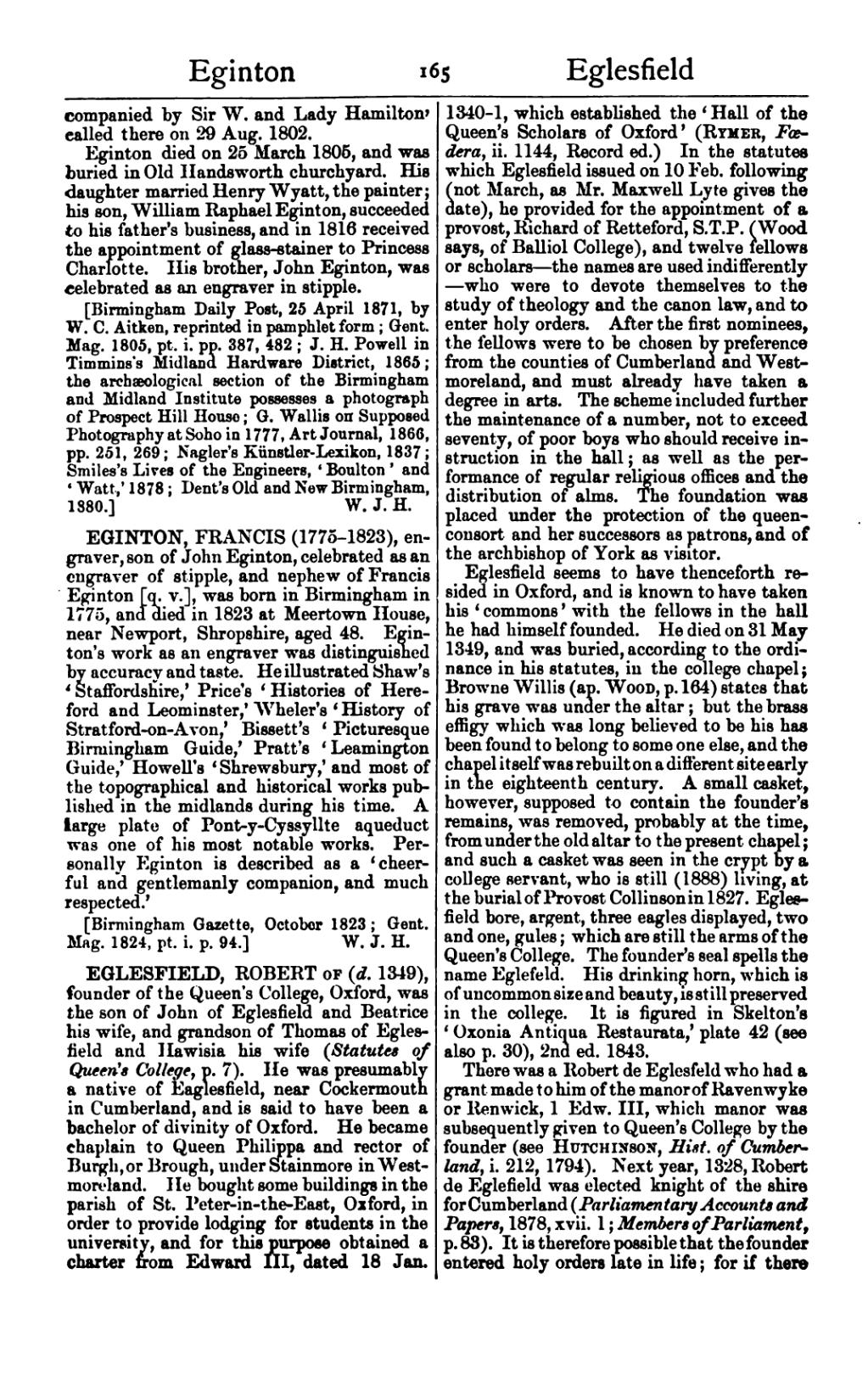companied by Sir W. and Lady Hamilton' called there on 29 Aug. 1802.
Eginton died on 26 March 1805, and was buried in Old Handsworth churchyard. His daughter married Henry Wyatt, the painter; his son, William Raphael Eginton, succeeded to his father's business, and in 1816 received the appointment of glass-stainer to Princess Charlotte. His brother, John Eginton, was celebrated as an engraver in stipple.
[Birmingham Daily Post, 25 April 1871, by W. C. Aitken, reprinted in pamphlet form; Gent. Mag. 1805, pt. i. pp. 387, 482; J. H. Powell in Timmins's Midland Hardware District, 1865; the archæological section of the Birmingham and Midland Institute possesses a photograph of Prospect Hill House; G. Wallis on Supposed Photography at Soho in 1777, Art Journal, 1866, pp. 251, 269; Nagler's Künstler-Lexikon, 1837; Smiles's Lives of the Engineers, 'Boulton' and 'Watt,' 1878; Dent's Old and New Birmingham, 1880.]
EGINTON, FRANCIS (1775–1823), engraver, son of John Eginton, celebrated as an engraver of stipple, and nephew of Francis Eginton [q. v.], was born in Birmingham in 1775, and died in 1823 at Meertown House, near Newport, Shropshire, aged 48. Eginton's work as an engraver was distinguished by accuracy and taste. He illustrated Shaw's 'Staffordshire,' Price's ' Histories of Hereford and Leominster,' Wheler's 'History of Stratford-on-Avon,' Bissett's 'Picturesque Birmingham Guide,' Pratt's 'Leamington Guide,' Howell's 'Shrewsbury,' and most of the topographical and historical works published in the midlands during his time. A large plate of Pont-y-Cyssyllte aqueduct was one of his most notable works. Personally Eginton is described as a 'cheerful and gentlemanly companion, and much respected.'
[Birmingham Gazette, October 1823; Gent. Mag. 1824, pt. i. p. 94.]
EGLESFIELD , ROBERT of (d. 1349), founder of the Queen's College, Oxford, was the son of John of Eglesfield and Beatrice his wife, and grandson of Thomas of Eglesfield and Hawisia his wife (Statutes of Queen's College, p. 7). He was presumably a native of Eaglesfield, near Cockermouth in Cumberland, and is said to have been a bachelor of divinity of Oxford. He became chaplain to Queen Philippa and rector of Burgh, or Brough, under Stainmore in Westmoreland. He bought some buildings in the parish of St. Peter-in-the-East, Oxford, in order to provide lodging for students in the university, and for this purpose obtained a charter from Edward III, dated 18 Jan. 1340-1, which established the 'Hall of the Queen's Scholars of Oxford' (Rymer, Fœdera, ii. 1144, Record ed.) In the statutes which Eglesfield issued on 10 Feb. following (not March, as Mr. Maxwell Lyte gives the date), he provided for the appointment of a provost, Richard of Retteford, S.T.P. (Wood says, of Balliol College), and twelve fellows or scholars — the names are used indifferently — who were to devote themselves to the study of theology and the canon law, and to enter holy orders. After the first nominees, the fellows were to be chosen by preference from the counties of Cumberland and Westmoreland, and must already have taken a degree in arts. The scheme included further the maintenance of a number, not to exceed seventy, of poor boys who should receive instruction in the hall; as well as the performance of regular religious offices and the distribution of alms. The foundation was placed under the protection of the queen-consort and her successors as patrons, and of the archbishop of York as visitor.
Eglesfield seems to have thenceforth resided in Oxford, and is known to have taken his 'commons' with the fellows in the hall he had himself founded. He died on 31 May 1349, and was buried, according to the ordinance in his statutes, in the college chapel; Browne Willis (ap. Wood, p. 164) states that his grave was under the altar; but the brass effigy which was long believed to be his has been found to belong to some one else, and the chapel itself was rebuilt on a different site early in the eighteenth century. A small casket, however, supposed to contain the founder's remains, was removed, probably at the time, from under the old altar to the present chapel; and such a casket was seen in the crypt by a college servant, who is still (1888) living, at the burial of Provost Collinson in 1827. Eglesfield bore, argent, three eagles displayed, two and one, gules; which are still the arms of the Queen's College. The founder's seal spells the name Eglefeld. His drinking horn, which is of uncommon size and beauty, is still preserved in the college. It is figured in Skelton's 'Oxonia Antiqua Restaurata,' plate 42 (see also p. 30), 2nd ed. 1843.
There was a Robert de Eglesfeld who had a grant made to him of the manor of Ravenwyke or Renwick, 1 Edw. III, which manor was subsequently given to Queen's College by the founder (see Hutchinson, Hist. of Cumberland, i. 212, 1794). Next year, 1328, Robert de Eglefield was elected knight of the shire for Cumberland (Parliamentary Accounts and Papers, 1878, xvii. l; Members of Parliament, p. 83). It is therefore possible that the founder entered holy orders late in life; for if there
